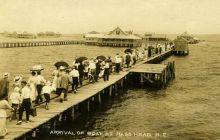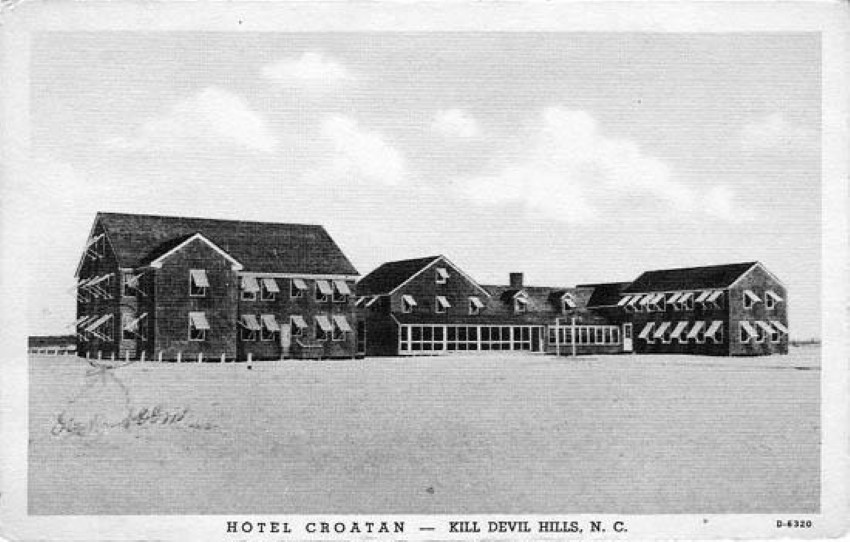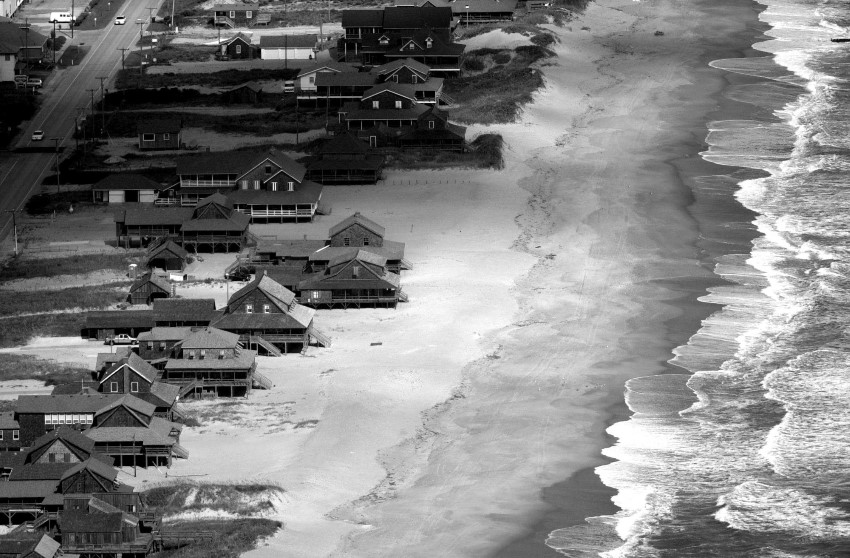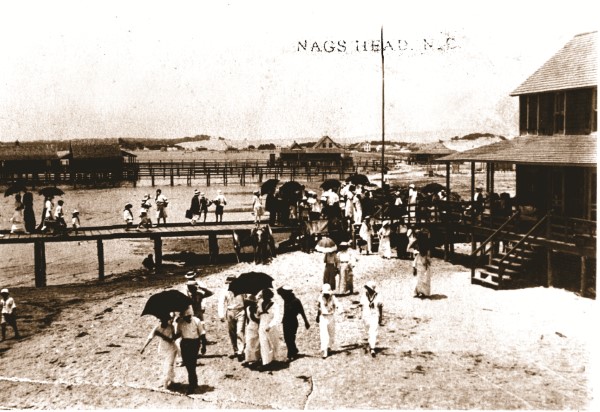
How Nags Head became the first beach resort in North Carolina.
As you drive the beach road today, it might be hard to imagine a time when the preponderance of places to stay were only several gracious beach-style hotels, mostly found in Nags Head. But if you can go back in your imagination to the 1930s and early ’40s, what you’d see would be vast stretches of undeveloped beachfront with the occasional two- or three-story hotel built of wood with wide porches, sloping rooflines and ample windows to let the sea breezes in. Peppering the sand dunes would be the neighboring historic Unpainted Aristocracy cottages, 13 of which were built as early as 1885 but all 40 of which would have been there by this mind visit. A few other structures would also be present, including an Episcopal church, but the majority of businesses and locals were still focused in the Flats, which was the densely wooded area between the sound and the sea, or on the sound side at this point.
So, to set the stage of how Nags Head had come to be known as the first beach resort in North Carolina, let’s go back another 100 years or so to the 1830s. We would see the beginning of this early tourism on the sound side in Nags Head. Malaria was rampant in the surrounding counties during that time, so physicians recommended (obviously to their patients who could afford it, which narrows the visitor demographic) that time at the beach, with its unpolluted air and constant breezes, was, if not a cure, at least a preventative. Though the history is sparse for a visit to the beach here, we can assume that these earliest of visitors stayed with locals since there were no other guest accommodations here then. But by 1838, the number of visitors, both for health and for healing, heading to the Outer Banks increased to a steady-enough flow to merit the first hotel to be envisioned.
Again, written accounts are few and far between – at least ones that are consistent enough that we can assume the history we’re reading is accurate and not just a recollection – but most agree that this first structure, built behind Jockey’s Ridge in 1840, was named Nags Head Hotel with accommodations for 200. Visitors would come in on steamboat and walk the soundside dock to the hotel. Bathing in the gentle sound waters was far preferable to visitors from this era than the ocean that contained crashing waves as well as dangerous sea creatures. But a danger of another sort brought this hotel to its end: the Civil War. Following the Battle of Roanoke in February of 1862, after which the Union took control of the area, Confederate General Henry A. Wise burned the structure to the ground so it could not provide comfort to the northerners.
The next hotel, The Alexina, was built in 1866 and managed by John Z. Lowe. It was the site of many happy summers but was torn down after being slowly devoured by encroaching sands from the ridge. Life on a moving sandbar has always presented challenges. There has long been a rumor that the remains of a hotel are buried under Jockey’s Ridge. While this might be true, the most accepted theory is that it’s actually only the pilings from The Alexina.

The next hotel to emerge was also managed by John Z. Lowe, but sand became a problem there too. This hotel burned in July 1903, and during the conflagration, Lowe’s wife died of a heart attack. A physician from Elizabeth City, Dr. C.S. Sawyer, then purchased what little was left of the hotel, moved it to nearby property he owned and started a boarding house, built on stilts out over the water to escape that pesky moving dune. He also built a large pavilion that was the center of evening summer activities until the beachfront became the favored vacationing site in the later 1930s.
Proof that these soundside accommodations were, indeed, the summer mecca can be seen in this comment from the Elizabeth City Economist, “This long established and favorite seaside summer resort of Eastern North Carolina will be open for the season, June 21, 1886, with several new attractions [including] a railroad from the pier to Ocean Beach, with a comfortable pavilion on the Sea Beach … [and] three restaurants on the Sound Side. There will be an abundance of cistern water for drinking.”
Several other hotels were built on the soundside by the time the 1800s drew to a close, including the Arlington, LeRoy’s Sea Side Hotel (later named First Colony Inn) and Hollowell. These structures were moved to the oceanfront in the early 1930s and were joined by the Parkerson and Hotel Nags Header. Up the beach at bit, in Kill Devil Hills, The Croatan was also built in the early 1930s in that same beach-style with ample porches and windows.

As wind, waves and fire would have it, the First Colony Inn, while moved off the oceanfront in August of 1988 to its current site between the highways in Nags Head, is the sole existing survivor of these beach-style grand dames that hosted countless people during the summers, many of them repeat visitors who would come for weeks or months at a time. Now, in 2019, you can look at the inn and let your imagination, again, go on an adventure, seeing in your mind’s eye the ladies with their parasols strolling the wraparound porches and the men in their funny, one-piece swimming outfits playing in the surf.
When the Currituck bridge opened for traffic in 1930, creating easy access by automobile, the Outer Banks began its boom years that would last for more than five decades. No longer was it mostly the wealthy eastern North Carolina landowners with their seaside cottages or those who could afford the boat travel here who made up the summer influx. Now, the average beach lover with a car could cross that bridge into this Outer Banks paradise.
And, of course, that meant that more accommodations were needed, and quick. Though there are far too many to mention by name, here are a few interesting stories of these hotels, some of which are still with us but many of which have been torn down to accommodate single-house vacation rentals.
Way up the beach, in what was then unincorporated Dare County but today is at the junction of Kitty Hawk and Southern Shores, Alice Sykes built the original Sea Ranch – and the resort included the first pool in Dare County! After the Ash Wednesday Storm in 1962, she moved the resort to its current location in Kill Devil Hills and expanded it through the years.
Just a bit south of the Sea Ranch today, the Wilbur Wright hotel was opened on July 1, 1939, by Annie and Thomas Baum. A few years later, their daughter, Diane Baum St. Clair, built the Orville Wright Motor Lodge. The two properties were happy companions for three decades until July 31, 1978, when a waterspout completely destroyed the Wilbur Wright. Diane decided to rename her surviving hotel the Wilbur and Orville Wright Motor Lodge, which eventually became what it is today under the ownership of Tess Judge and partners, The Days Inn Oceanfront Wright Brothers.

The Carolinian joined the offerings in the 1940s, and though it didn’t follow the architecture of the others, it maintained and heightened the concept of gracious Outer Banks vacationing. The Dory Deck on the ocean side was the site of many a gala and a popular after-hours gathering spot. As is the case with all but First Colony, this gracious structure was torn down in 2001 to make way for rental houses.
Though previously cited, the Hotel Nags Header deserves another mention, for two reasons. One, it was the first hotel on the Outer Banks to provide hot and cold running water in all of its 31 guest rooms; and, two, it was legendary for its Tap Room. If you were on the Outer Banks until 1977 (when the town condemned then burned the hotel ) and of drinking age (18 at that point), this was probably the place you hung out every summer night to listen to the bands and define what being young and free meant.
The editor of the Elizabeth City North Carolinia must have been prescient about what was to come for visitors to the Outer Banks some 100 years later when he wrote in 1874, “A number of citizens are making preparations to spend the summer at Nag’s Head. Some do worship at the Shrine of Hygeia, others that of Cupid and Terpsichore, and still others, we fear will worship and fall down at the feet of Bacchus. Health to the first! Pleasure to the second! And to the third the mildest of head-aches in the morning. “


 Beth Storie first came to the Outer Banks for the summer of 1976. She fell in love with the area and returned for good three years later. She and her husband published the national guidebook series, The Insiders' Guides, for more than 20 years and now are building OneBoat guides into another national brand. After spending time in many dozens of cities around the country, she absolutely believes that her hometown of Manteo is the best place on earth, especially when her two children, six cats and one dog are there too.
Beth Storie first came to the Outer Banks for the summer of 1976. She fell in love with the area and returned for good three years later. She and her husband published the national guidebook series, The Insiders' Guides, for more than 20 years and now are building OneBoat guides into another national brand. After spending time in many dozens of cities around the country, she absolutely believes that her hometown of Manteo is the best place on earth, especially when her two children, six cats and one dog are there too.




